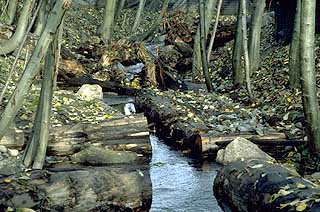
Surveys
DJC.COM
April 19, 2001
Shedding light on the watershed
Artist

|
Natural phenomena such as pouring rain, flowing rivers and evaporating oceans carve the earth’s surface into watersheds, an ancient geographical unit. Can the watershed now become a physical and conceptual framework within which to reclaim habitat, develop infrastructure and create places for people?
Watershed Illuminations is an artist-initiated program that aims to answer this question.
Developed in 1997 during my residency within Seattle Public Utilities, and sponsored by the Seattle Arts Commission, the program engages people in an exploration of a variety of watersheds and water resources: a water supply watershed, an urban creek watershed, an inner city watershed, wetlands, ponds, lakes and reservoirs.

|
As a part of the artist-in-residence program, I created a city-wide arts master plan that outlined ways for the utility to integrate the work and ideas of artists into its activities. The Watersheds Illuminations initiative evolved directly from the artist’s interactions with city staff, elected officials and community members.
The pilot project for Watersheds Illuminations is an urban creek restoration in West Seattle. Begun in 1999, the Longfellow Creek habitat improvement project helps improve drainage in a 2,685-acre watershed and supports the Delridge neighborhood plan to develop creekside access and trails. Seattle Public Utilities is working in partnership with the Seattle Arts Commission and the Seattle Parks and Recreation Department to reshape Longfellow Creek.
The site was an overgrown five-acre open space straddling Longfellow Creek. Problems included obstruction of fish passages, deteriorating public access, overgrown blackberries, illegal dumping and a creek which did not handle or control drainage well.
The renovation of the creek is a result of a collaboration between artist, engineers and landscape architects. As the artist, I created a master plan for the pilot project. The plan aims to bring the wonders of the urban creek habitat to light and educate people about bringing salmon into the city, water-wise gardening and other sustainable strategies.
The artwork connects people to the watershed through a series of outdoor rooms that accentuate the creek’s role in draining water and ecological diversity of a healthy creek environment. The framework of the design is a series of outdoor “rooms” that include earthworks, gardens, a pavilion, a bridge, an amphitheater and an overlook.
The Dragonfly Garden is the dramatic entry to the site. A neighborhood-friendly planting fronts the street and provides a plane of low greenery and groves of purple-leafed trees. The visitor enters along a paved pathway that resembles a dragonfly’s abdomen. Inside, a pavilion, earthworks and plantings suggest the shape of a dragonfly, whose presence symbolizes a healthier habitat.
The garden itself is a larger-than-life outline of the insect. On both sides of the path, wing-shaped earthworks and gardens present a mosaic of drought-resistant plants that provide a stable backbone of winter structure and a succession of seasonal blooms.
The plants require little maintenance and illustrate good choices for the home gardener because they are tough and water-wise. Many of the perennials are insect-friendly plants that attract hummingbirds as well. The wing shapes lie in a cultivated meadow that consists of two types of grasses, both of which sprout green in the spring and fade to buff in late summer and fall. They move with the breezes that pass over the site, and also create a foil of color and texture for the plantings inside the wings.
Down the path, the visitor encounters the Dragonfly Pavilion, which appears to fly through a grove of quaking aspens. The aspens, as well as a stand of tall grasses and plumes of purple smokebush, provide a fluttery backdrop for the Dragonfly Garden.
Dragonfly morphology informs the design of the pavilion, which consists of a seating wall with a gathering area, trellis, bridgeway and overlook. The trellis suggests a segmented, undulating body, and the shape of the overlook’s platform is inspired by the dragonfly’s bulbous eyes. The railing and protruding overlook are reminiscent of the formidable dragonfly jaw. The pavilion’s roof, composed of curvy steel frames that hold multicolored iridescent glass panels, evokes the veining and color of a dragonfly’s wings. The glass and its framework cast subtle patterns of colored light and shadow, and mosaic benches provide a place to rest.
The Dragonfly Garden is situated on a hilltop and offers vistas of the watershed’s rolling topography. From the pavilion, the visitor can see plantings that range from ornamental, drought-resistant varieties in the upland garden to those associated with the creek environment toward the east. Dogwoods and willows are at their peak of color in the autumn. Many of these plants provide year-round cover for birds.
Several other elements of the Longfellow Creek project are also designed to provide greater connection between neighborhood and creek.
The Bridge Pavilion and Hatch Meadow are adjacent to a fish spawning area, and they provide a terrestrial echo of the underwater habitat. The Bridge Pavilion refers abstractly to the skeletal structure of a fish. In the Hatch Meadow, the visitor can sit on pink mosaic spheres that resemble salmon eggs.
Deep in the creek’s watershed, the Fern Amphitheater heightens the experience of a wet, forested depression. The shape of an unfurling fern informs the design of a bridge/overlook positioned to keep people at the edge of the fish-rearing habitat. Plantings include ferns, cedars, willows and skunk cabbage.
The Yancy Entry, a secondary entry adjacent to a steel mill, incorporates recycled metal. A trellis inspired by the elemental forms of creek microorganisms provides an armature for native vines.
A short distance off the main trail is the Lunker Glade, a rest area for visitors parallels the creek’s engineered resting spots for fish, which are called lunkers. The bench design incorporates forms related to amphibians. Stream enhancements for fish designed by team engineers include better spawning habitat, rearing ponds and lunkers. Timber step-ups enable fish to swim up the creek.
The Bridge Pavilion and the Dragonfly Garden are currently funded, while the other outdoor rooms are part of future phases. Stream enhancements and plantings designed by team engineers and landscape architects are also complete. The first phase of the project is nearing the end of construction and a second design and planning phase has begun.
This site differs from many other parks. Typically, parks offer a limited experience of nature because they are mostly places for recreation within a natural setting. Or they mimic nature to the point that the design is illegible. This project aims to capture the emotive potential of the Northwest landscape and to engage the imagination so that people can appreciate, protect and interact with this urban creek watershed. In order to bring back salmon, the whole ecosystem must be rehabilitated.
Lorna Jordan is a Seattle-based environmental artist working on a series of projects related to watersheds.
Other Stories:
- Seattle adapts to life at the top
- Going digital
- New views of sustainable site design from Rainier Vista
- Giving street trees a better chance
- New rules may kill off pesticide use
- Seattle Chinese Garden: a people place
- LEED and the landscape architect
- Private projects become urban environments
- Inviting nature back to the neighborhood
- New respect for the land drives highway design
- Expanding services in times of slowdown:
Thoughts on surviving and thriving with clients - Keeping history alive
- Common ground
- Designing for the journey
Copyright ©2009 Seattle Daily Journal and DJC.COM.
Comments? Questions? Contact us.